6 Dental Insights from Q4 2023 and What They Mean for You
December 7, 2023
According to Indeed.com, the growth rate for open dental job postings continues to decline, as labor markets improve for practice owners and managers. The loosening labor market has caused wage growth for dental offices to fall below the national and healthcare industry averages. Although patients’ interest in dentistry is still high compared to pre-pandemic levels, that number has started to trend down. According to Google Trends data, searches for “dentist near me” have declined.
On a positive note, demand for elective dentistry remains high. Technology will continue to grow in importance as artificial intelligence (AI) impacts the healthcare industry as a whole; forecasts predict AI usage will grow at an annual rate of 37.5% between now and 2030. Investment in tech has been a key driver of industry consolidation with recent merger and acquisition (M&A) activity returning to more normal levels, as dealmakers have grown more cautious in the face of higher financing costs and economic uncertainty.
Here are six key takeaways to keep in mind as we head into next year.
1. The job market has become more favorable for dental offices.
According to Indeed.com, the number of open dental job postings only grew 4.8% year-over-year, continuing to decline from 2021 heights. Still, the dental job postings growth rate remains higher than the national average, as it has since the summer of 2022.
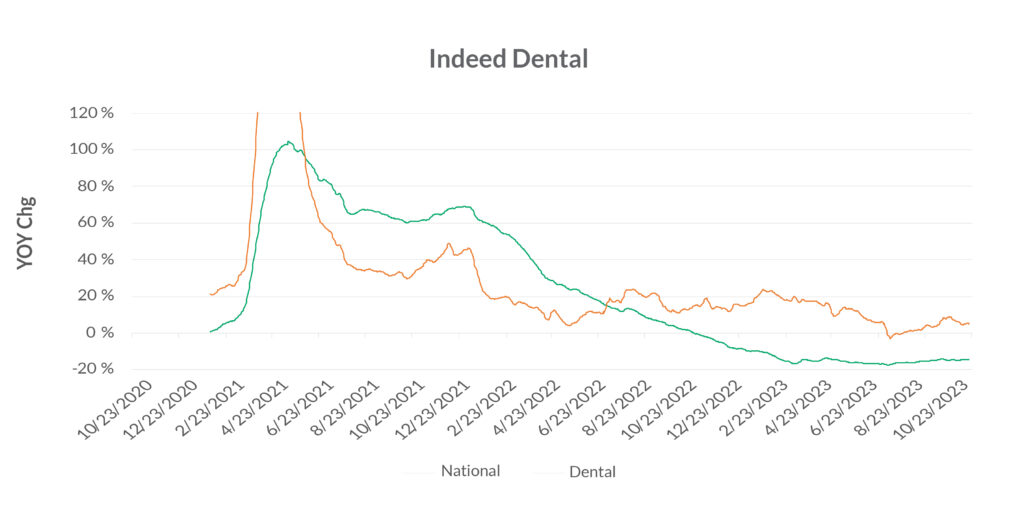
According to Indeed.com, the number of open dental job postings only grew 4.8% year-over-year, continuing to decline from 2021 heights. Still, the dental job postings growth rate remains higher than the national average, as it has since the summer of 2022.
Key takeaway: The declining dental job postings growth rate indicates that the quit rate has slowed. This gives employers greater leverage in negotiating fairer wages since job seekers’ options may be more limited.
2. Looser labor markets are pressuring dental wages.
Wage growth rates in dental offices are lower than both the national average and the overall healthcare industry, sitting near pre-pandemic levels. Due to this decline, inflationary pressures are subsiding.
As supported by the prior chart, the declining dental practice wage growth rate is a result of loosening labor market conditions.
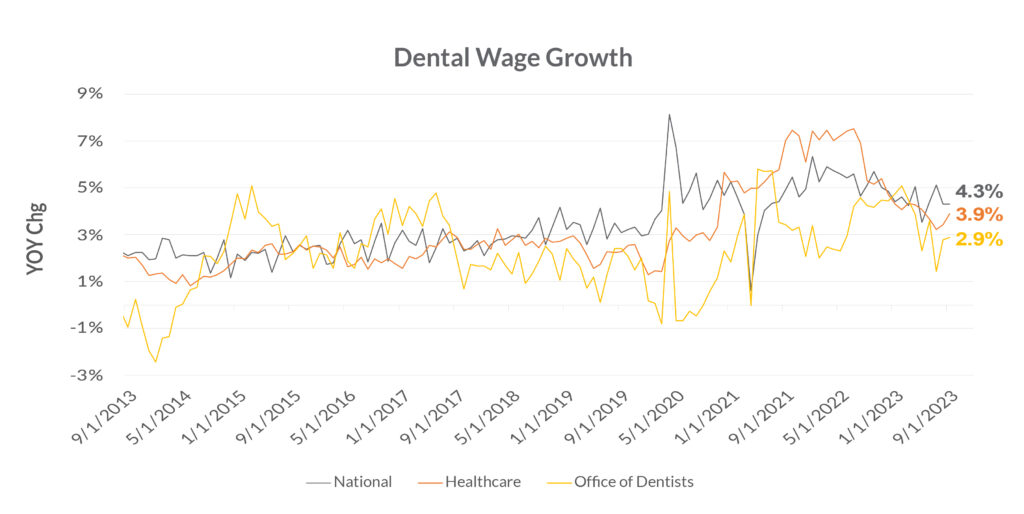
Key takeaway: Practice owners should pay attention to larger labor market conditions when negotiating wages with existing or potential employees. If markets loosen, owners can manage salary expenses more effectively, positively impacting profitability. In contrast, if markets tighten, practice owners should explore non-financial benefits, such as staffing flexibility, to retain and attract employees.
3. Google searches for dentists continue to decline.
Google Trends data shows that the number of searches for “dentist near me” continued to decline off the post-pandemic peak in 2021. However, the level of interest remains relatively high as searches are still near pre-pandemic levels.
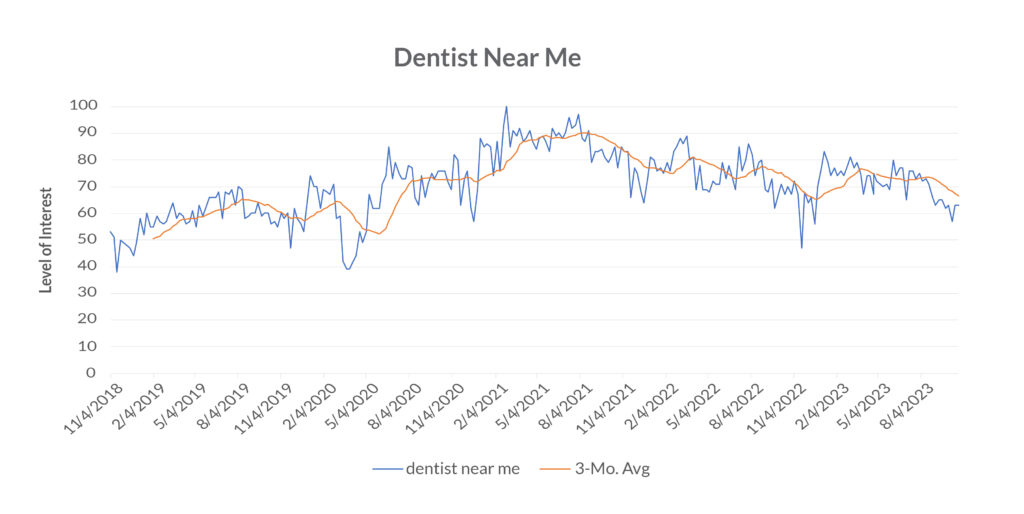
Key takeaway: With the pandemic driving population migration, many patients have found new dentists as they moved to different areas of the country. Now that patients’ lives are more settled, their interest in new dentists has decreased. However, the pandemic created more work flexibility, which means that dental practices may experience more patient turnover than they have historically. Practice owners should maintain active online advertising efforts.
4. Demand for elective dentistry remains elevated.
Google search trends for Invisalign braces indicate that the demand for elective dentistry remains high, despite rising interest rates and economic uncertainty.
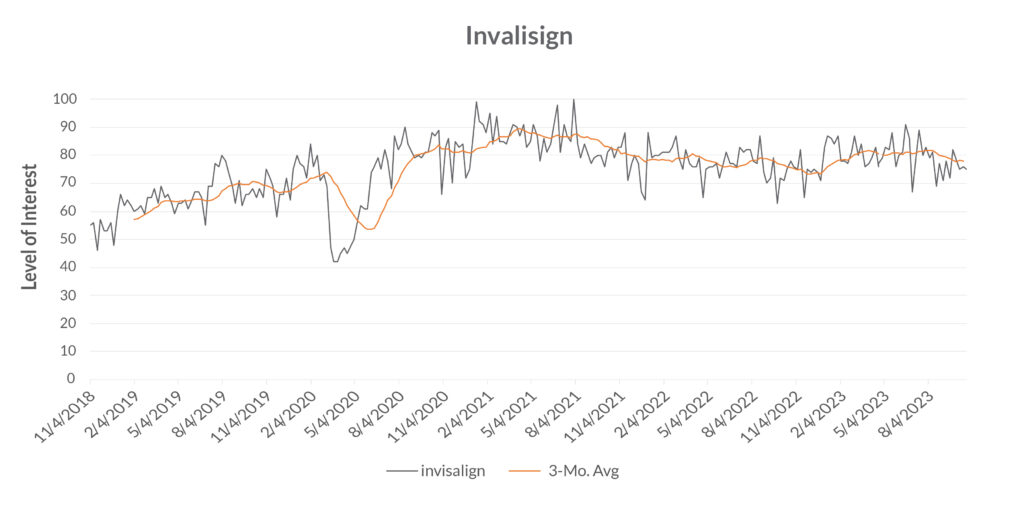
Key takeaway: Elective dentistry, such as Invisalign, can be a key profitability driver for dental practices. With strong housing prices, significant home equity, low unemployment and solid balance sheets, middle- and upper-income patients still feel positive about their financial situations, which could positively impact the demand for elective dentistry. Practice owners should actively advertise their elective dentistry services in the new year.
5. AI in the US healthcare market is set to grow exponentially.
AI has taken the world by storm with extraordinary growth over the past year. For healthcare organizations, including dentists, AI presents tremendous opportunities to drive greater productivity, and thus, profitability. Forecasts suggest that this is just the beginning, as AI in healthcare is expected to grow at 37.5% a year until 2030 and become a $208 billion industry.
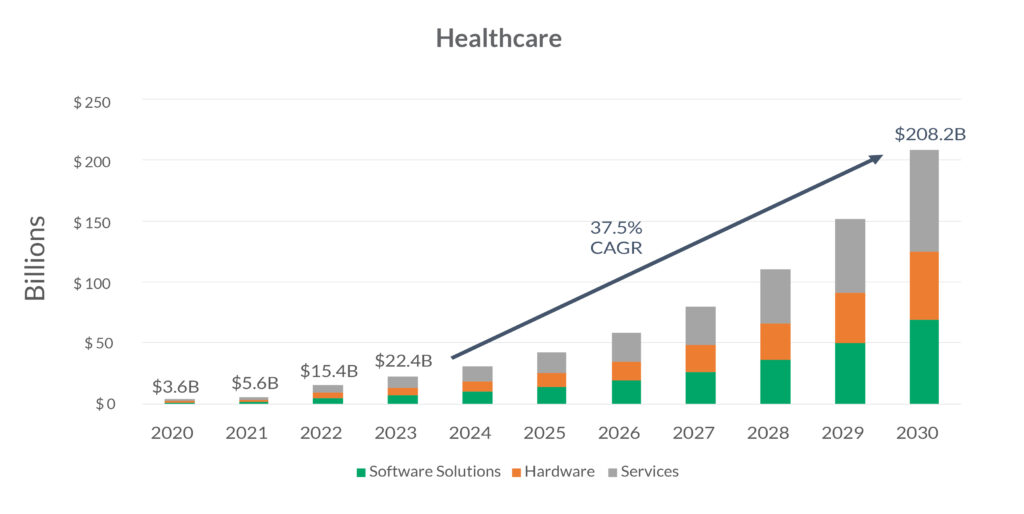
Key takeaway: To stay competitive in the marketplace, dental practice owners should look for ways to use AI to increase productivity and scale. Look for AI solutions that your staff can easily adopt and apply to your practice, such as tools that automate administrative processes or x-ray diagnostics.
6. M&A activity in the healthcare space subsided last quarter.
Following significant consolidation in 2021 and 2022, M&A activity has slowed to more historical levels, as the increased cost of financing and higher economic uncertainty have made dealmakers more discerning.
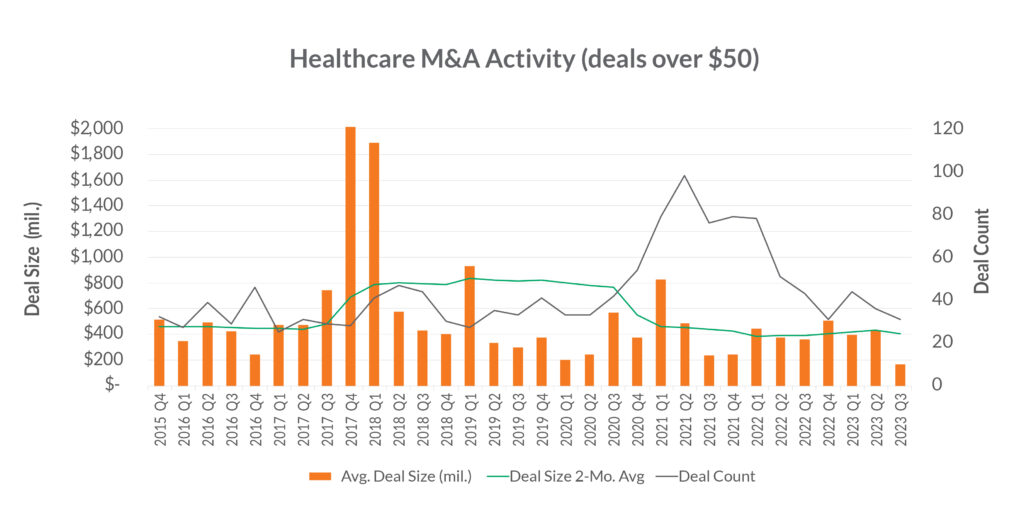
Key takeaway: With the M&A market cooling, dental practice owners should shift their focus toward driving organic growth. To remain competitive and scale your practice, consider adopting new tools and technology (particularly AI), and enhance flexibility for your patients with telehealth and digital payment options.
Disclosures
Investment advisory services are offered by Aprio Wealth Management, LLC, a Securities and Exchange Commission Registered Investment Advisor. Opinions expressed are as of the current date (December 1, 2023) and subject to change without notice. Aprio Wealth Management, LLC shall not be responsible for any trading decisions, damages, or other losses resulting from, or related to, the information, data, analyses or opinions contained herein or their use, which do not constitute investment advice, are provided as of the date written, are provided solely for informational purposes and therefore are not an offer to buy or sell a security. This commentary is for informational purposes only and has not been tailored to suit any individual. References to specific securities or investment options should not be considered an offer to purchase or sell that specific investment.
This commentary contains certain forward-looking statements. Forward-looking statements involve known and unknown risks, uncertainties and other factors which may cause the actual results to differ materially and/or substantially from any future results, performance or achievements expressed or implied by those projected in the forward-looking statements for any reason.
No graph, chart, or formula in this presentation can be used in and of itself to determine which securities to buy or sell, when to buy or sell securities, whether to invest using this investment strategy, or whether to engage Aprio Wealth Management, LLC’s investment advisory services.
Investments in securities are subject to investment risk, including possible loss of principal. Prices of securities may fluctuate from time to time and may even become valueless. Any securities mentioned in this commentary are not FDIC-insured, may lose value, and are not guaranteed by a bank or other financial institution. Before making any investment decision, investors should read and consider all the relevant investment product information. Investors should seriously consider if the investment is suitable for them by referencing their own financial position, investment objectives, and risk profile before making any investment decision. There can be no assurance that any financial strategy will be successful.
Securities offered through Purshe Kaplan Sterling Investments. Member FINRA/SIPC. Investment Advisory Services offered through Aprio Wealth Management, LLC, a registered investment advisor. Aprio Wealth Management, LLC and the Aprio Group of Companies are not affiliated with Purshe Kaplan Sterling Investments.
Stay informed with Aprio.
Get industry news and leading insights delivered straight to your inbox.
Recent Articles
About the Author
Simeon Wallis
Simeon is the Chief Investment Officer of Aprio Wealth Management and the Director of Aprio Family Office. Simeon brings two decades of professional investing experience in publicly traded and privately held companies, as well as senior-level operating and strategy consulting experiences.


